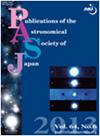Discovery of a molecular cloud possibly associated with the youngest Galactic SNR G1.9+0.3
IF 2.2
4区 物理与天体物理
Q2 ASTRONOMY & ASTROPHYSICS
引用次数: 1
Abstract
Abstract The youngest known Galactic supernova remnant (SNR) G1.9+0.3 has high-velocity supernova shock beyond 10000 km s−1, and it is considered to be one of the major candidates of a PeVatron. Despite these outstanding properties, the surrounding interstellar matter of this object is poorly understood. We investigated the interstellar gas toward G1.9+0.3 using the 12CO(J = 3−2) data with the angular resolution of 15″ obtained by the CHIMPS2 survey by the James Clerk Maxwell Telescope, and discovered three individual clouds at −1, 7, and 45 km s−1. From its morphological and velocity structures, the −1 km s−1 cloud, having the largest velocity width >20 km s−1 and located at the distance of the Galactic Center, is possibly associated with the SNR. The associated cloud shows a cavity structure both in space and velocity and coincides well with the SNR. We found that the associated cloud has higher column densities toward three bright, radio synchrotron-emitted rims where the radial expansion velocity of the supernova shock is decelerated, and the cloud is faint in the other parts of the SNR. This is the first direct evidence indicating that the highly anisotropic expansion of G1.9+0.3 observed by previous studies results from the deceleration by the interaction between the supernova shock and surrounding dense interstellar medium.发现可能与最年轻的银河系信噪比G1.9+0.3有关的分子云
已知最年轻的银河系超新星遗迹(SNR) G1.9+0.3具有超过10000 km s−1的高速超新星激波,被认为是PeVatron的主要候选者之一。尽管有这些杰出的特性,但人们对这个天体周围的星际物质知之甚少。我们利用詹姆斯克拉克麦克斯韦望远镜(James Clerk Maxwell Telescope)对黑猩猩2巡天获得的角分辨率为15″的12CO(J = 3−2)数据研究了G1.9+0.3方向的星际气体,并在- 1、7和45 km s−1处发现了三个独立的云。从其形态和速度结构来看,- 1 km s - 1的云,其最大速度宽度为20 km s - 1,位于银河系中心的距离,可能与信噪比有关。伴生云在空间和速度上均呈空腔结构,与信噪比吻合较好。我们发现,在超新星激波的径向膨胀速度减慢的三个明亮的射电同步辐射边缘处,相关云团的柱密度较高,而在信噪比的其他部分,云团的柱密度较暗。这是第一个直接证据,表明先前研究中观测到的G1.9+0.3的高度各向异性膨胀是超新星激波与周围致密星际介质相互作用减速的结果。
本文章由计算机程序翻译,如有差异,请以英文原文为准。
求助全文
约1分钟内获得全文
求助全文
来源期刊

Publications of the Astronomical Society of Japan
地学天文-天文与天体物理
CiteScore
4.10
自引率
13.00%
发文量
98
审稿时长
4-8 weeks
期刊介绍:
Publications of the Astronomical Society of Japan (PASJ) publishes the results of original research in all aspects of astronomy, astrophysics, and fields closely related to them.
 求助内容:
求助内容: 应助结果提醒方式:
应助结果提醒方式:


